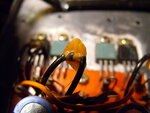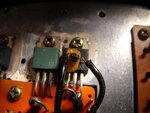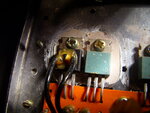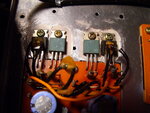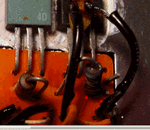scottam
Newbie level 4
So I found this pretty nice Pioneer H-2001 receiver which works great mechanically, but the right channel on the amplifier circuit board is blown. Someone probably had too wild a party listening to a pink floyd vinyl back in the day.
In any case, I see a couple resistors are burned which I can easily replace, but there are also some odd looking components glued to the tops of the power transistors (I think that's what they are... one is labeled C1173 [black one] and the other A473 [green]). On the right channel of the circuit, these components are fried, but on the left they are fine. They look a bit like some sort of ceramic capacitors, but there are no markings beyond half of it being painted black.
I've attached photos below. Can anyone tell me what these might be?
Thanks!
Scott
In any case, I see a couple resistors are burned which I can easily replace, but there are also some odd looking components glued to the tops of the power transistors (I think that's what they are... one is labeled C1173 [black one] and the other A473 [green]). On the right channel of the circuit, these components are fried, but on the left they are fine. They look a bit like some sort of ceramic capacitors, but there are no markings beyond half of it being painted black.
I've attached photos below. Can anyone tell me what these might be?
Thanks!
Scott
